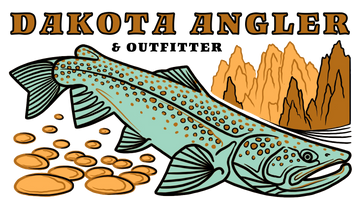As we move into late summer, the dry-dropper rig becomes increasingly more effective and we find ourselves using them more often than not. With the warmer water, a lot of the fish have moved into shallower/faster water and near the banks where they are more likely to encounter terrestrial insects. In addition, you don't need to fish a standard nymph rig in this type of shallow water - a tungsten nymph under a hopper will get down to the fish plenty fast. Dry dropper rigs are much more pleasant to cast than a standard indicator rig, and they're very effective in late summer. Here's a few tips to make your dry dropper fishing more effective.
1 - Fish the right water - A dry/dropper rig gets pretty difficult to cast if the distance between the dry and the nymph is over about 36", so they won't be the most effective setup in a hole that's 6 feet deep. For the most success, focus on riffles and banks that are shin to knee deep and you'll find considerably more success.
2 - Match your dry to your nymph - To have a dry/dropper rig be effective, you have to match the weight of your nymph to the size of your dry fly - if the nymph is too heavy for the dry fly to hold up, you're going to have a really tough time seeing strikes, and you won't get the visual aspect of the fish eating your dry fly. In lower, clearer water you can size down to a size 14 or 16 parachute dry with an 18-20 tungsten nymph underneath, but during higher flows you'll want to up the size of the dry to a size 8-12 hopper/other bouyant fly and a larger, heavier tungsten nymph that can get down faster.
3 - Fish a dry fly that's easy to see - When fishing a dry/dropper rig, the majority of your bites are typically going to be on the nymph. Because the dry is your strike indicator, you want to make sure and fish a dry fly that's big enough to easily see, particularly in choppy, riffly water. Our favorites for late summer are Micro Chubbies in black or tan, Fat Franks, and Hippie Stompers in size 12. All of those flies have big wings that make them easy to see, but have a small enough body that the fish are still eager to eat them.
4 - Make sure the distance between your flies is correct - As with any nymph fishing, it's important to have your fly within a foot of the bottom of the river. Most of the riffles and faster banks are going to be less than 24" deep, so a good place to start with your dropper length is around that same distance. Anywhere from 18" to 36" is doable, but any longer than that and your casting can start to suffer.
5 - Fish a short leader - On smaller streams like we have in the Black Hills, a leader that's much longer than the length of your rod is overkill. A shorter leader will turn the air-resistant hopper patterns over easier, and your casting is more accurate as well. A 7.5' 3x leader is a good place to start - the heavier tippet helps keep bulky flies from twisting. If the fish are going to eat a big hopper pattern, they typically aren't going to be tippet shy anyways.
Fishing a dry/dropper rig is a nice change of pace from nymph fishing, and it can be really effective during late summer!


